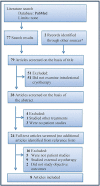Intralesional Cryotherapy for the Treatment of Keloid Scars: Evaluating Effectiveness
- PMID: 26180738
- PMCID: PMC4494507
- DOI: 10.1097/GOX.0000000000000348
Intralesional Cryotherapy for the Treatment of Keloid Scars: Evaluating Effectiveness
Abstract
Background: Intralesional (IL) cryotherapy is a novel treatment technique for keloid scars, in which the scar is frozen from inside. Over the past decade, several studies have been published with varying outcomes. A critical analysis of the current literature is, therefore, warranted to determine whether IL cryotherapy is an alternative to established keloid scar treatments.
Methods: A comprehensive review was performed, based on the Preferred Reporting Items for Systematic Reviews and Meta-Analysis. PubMed and EMBASE were searched from inception. Studies and level of recommendation were graded according to the American Society of Plastic Surgeons criteria.
Results: Eight studies meeting the inclusion criteria were selected. The average scar volume decrease ranged from 51% to 63%, but no complete scar eradication was achieved on average. Scar recurrence ranged from 0% to 24%. Hypopigmentation posttreatment was seen mostly in Fitzpatrick 4-6 skin type patients. Finally, complaints of pain and pruritus decreased significantly in most studies.
Conclusions: IL cryotherapy for the treatment of keloid scars shows favorable results in terms of volume reduction and alleviated complaints of pain and pruritus. However, no complete scar eradication is established, and recurrences are seen. Also, persistent hypopigmentation proved a problem in Fitzpatrick 4-6 skin type patients. Summarized, the evidence proved limited and inconsistent resulting in an American Society of Plastic Surgeons grade C recommendation for this type of treatment of keloid scars.
Conflict of interest statement
Figures
References
-
- Niessen FB, Spauwen PH, Schalkwijk J, et al. On the nature of hypertrophic scars and keloids: a review. Plast Reconstr Surg. 1999;104:1435–1458. - PubMed
-
- Bock O, Schmid-Ott G, Malewski P, et al. Quality of life of patients with keloid and hypertrophic scarring. Arch Dermatol Res. 2006;297:433–438. - PubMed
-
- Gupta S, Sharma VK. Standard guidelines of care: keloids and hypertrophic scars. Indian J Dermatol Venereol Leprol. 2011;77:94–100. - PubMed
-
- Ledon JA, Savas J, Franca K, et al. Intralesional treatment for keloids and hypertrophic scars: a review. Dermatol Surg. 2013;39:1745–1757. - PubMed
-
- Juckett G, Hartman-Adams H. Management of keloids and hypertrophic scars. Am Fam Physician. 2009;80:253–260. - PubMed
Publication types
LinkOut - more resources
Full Text Sources
Miscellaneous

